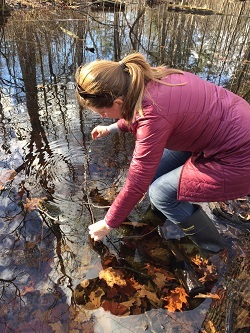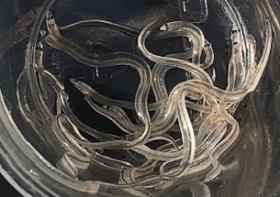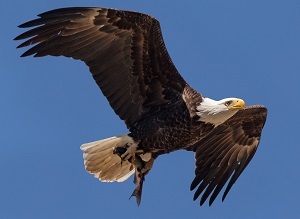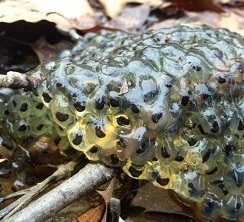Spring in the Hudson Valley
 During Earth Week in April, we pay special attention to our environment. However, the work of caring for the land and waters around us is a daily effort. Environmental organizations, research institutions, colleges and universities, watershed groups, local officials, and community volunteers all help to conserve, restore, and protect these special places. During Earth Week in April, we pay special attention to our environment. However, the work of caring for the land and waters around us is a daily effort. Environmental organizations, research institutions, colleges and universities, watershed groups, local officials, and community volunteers all help to conserve, restore, and protect these special places.
While some of this work is now on pause, it is both reassuring and comforting to know that despite the COVID-19 coronavirus, we are having an on-time arrival of spring in the Hudson River watershed. Eagles and great horned owls have nestlings; osprey and great blue herons are on eggs, and the results of a successful amphibian migration season can be observed in woodland pools. Juvenile glass eels continue to make their way from the Sargasso Sea into tidal estuaries like the Hudson, transforming into fresh water creatures as they migrate into streams and tributaries. Below are recent observations of this activity from the weekly nature journal, Hudson River Almanac. Subscribe!
The Hudson River Eel Project
The eel project is continuing on a scaled-back basis, without volunteers or students. DEC staff are following strict safety and distancing protocols.
 3/29 – Ulster County: Despite a steady drizzle and a brisk running current in this Hudson River tributary, checking our glass eel research fyke net was wonderful. The overnight set had a nice haul of juvenile glass eels, little ribbons of life that connected me instantly to the Sargasso Sea, a thousand miles away in the mid-Atlantic. 3/29 – Ulster County: Despite a steady drizzle and a brisk running current in this Hudson River tributary, checking our glass eel research fyke net was wonderful. The overnight set had a nice haul of juvenile glass eels, little ribbons of life that connected me instantly to the Sargasso Sea, a thousand miles away in the mid-Atlantic.
Four larger elvers, called yearlings, were also in the net. They had survived the gauntlet of their first year in the estuary. Among the eels were several caddisflies, architectural insects with homes of leaves or sticks or tiny stones. On the bright yellow tennis balls that lined the net stakes, new hatches of stone flies gathered. The entire scene was a tableau of survival and beauty and life, even in tough times. The water temperature was 46 degrees; the air temperature was 50 degrees.
- Chris Bowser

Hungry Eagle Nestlings
 It was a day of double fish delivery at bald eagle nest NY62. Each of the adults brought a fish, one a gorgeous goldfish, the other a robust channel catfish. We are still figuring there is only one nestling, however, albeit one with a voracious appetite. It was a day of double fish delivery at bald eagle nest NY62. Each of the adults brought a fish, one a gorgeous goldfish, the other a robust channel catfish. We are still figuring there is only one nestling, however, albeit one with a voracious appetite.
- Bob Rightmyer
We like to think of bald eagle nest NY62 as a good representation of other eagle nests in the Hudson River watershed, especially those that we are unable to faithfully monitor. The female in NY62, from three different nests, had now produced a remarkable 22 nestlings across 20 years.
- Tom Lake
Bald eagle photo by Bob Rightmeyer
Emerging Life in Woodland Pools
 At this point in the season, the result of successful migrations can be observed by visiting woodland pools. In the mid and lower Hudson estuary watershed, egg masses of wood frog, spotted salamander, and Jefferson-blue spotted salamander complex are developing under water, still weeks away from hatching into frog tadpoles or salamander larvae. Further north in the estuary watershed, where the breeding season gets a later start, male wood frogs may still be calling from woodland pools to lure females for breeding. Their distinct call resembles the sound of quacking ducks. At this point in the season, the result of successful migrations can be observed by visiting woodland pools. In the mid and lower Hudson estuary watershed, egg masses of wood frog, spotted salamander, and Jefferson-blue spotted salamander complex are developing under water, still weeks away from hatching into frog tadpoles or salamander larvae. Further north in the estuary watershed, where the breeding season gets a later start, male wood frogs may still be calling from woodland pools to lure females for breeding. Their distinct call resembles the sound of quacking ducks.
Stay Home
 I will be standing in the woods I will be standing in the woods
where the old trees
move only with the wind
and then with gravity.
In the stillness of the trees
I am at home. Don’t come with me.
You stay home too.
-This verse is from the poem 'Stay Home' by Wendell Berry
Tom Lake, Chris Bowser, and Laura Heady contributed to this issue of Hudson RiverNet.
|


 During Earth Week in April, we pay special attention to our environment. However, the work of caring for the land and waters around us is a daily effort. Environmental organizations, research institutions, colleges and universities, watershed groups, local officials, and community volunteers all help to conserve, restore, and protect these special places.
During Earth Week in April, we pay special attention to our environment. However, the work of caring for the land and waters around us is a daily effort. Environmental organizations, research institutions, colleges and universities, watershed groups, local officials, and community volunteers all help to conserve, restore, and protect these special places. 3/29 – Ulster County: Despite a steady drizzle and a brisk running current in this Hudson River tributary, checking our glass eel research fyke net was wonderful. The overnight set had a nice haul of juvenile glass eels, little ribbons of life that connected me instantly to the Sargasso Sea, a thousand miles away in the mid-Atlantic.
3/29 – Ulster County: Despite a steady drizzle and a brisk running current in this Hudson River tributary, checking our glass eel research fyke net was wonderful. The overnight set had a nice haul of juvenile glass eels, little ribbons of life that connected me instantly to the Sargasso Sea, a thousand miles away in the mid-Atlantic.
 It was a day of double fish delivery at bald eagle nest NY62. Each of the adults brought a fish, one a gorgeous goldfish, the other a robust channel catfish. We are still figuring there is only one nestling, however, albeit one with a voracious appetite.
It was a day of double fish delivery at bald eagle nest NY62. Each of the adults brought a fish, one a gorgeous goldfish, the other a robust channel catfish. We are still figuring there is only one nestling, however, albeit one with a voracious appetite. At this point in the season, the result of successful migrations can be observed by visiting woodland pools. In the mid and lower Hudson estuary watershed, egg masses of wood frog, spotted salamander, and Jefferson-blue spotted salamander complex are developing under water, still weeks away from hatching into frog tadpoles or salamander larvae. Further north in the estuary watershed, where the breeding season gets a later start, male wood frogs may still be calling from woodland pools to lure females for breeding. Their distinct call resembles the sound of
At this point in the season, the result of successful migrations can be observed by visiting woodland pools. In the mid and lower Hudson estuary watershed, egg masses of wood frog, spotted salamander, and Jefferson-blue spotted salamander complex are developing under water, still weeks away from hatching into frog tadpoles or salamander larvae. Further north in the estuary watershed, where the breeding season gets a later start, male wood frogs may still be calling from woodland pools to lure females for breeding. Their distinct call resembles the sound of  I will be standing in the woods
I will be standing in the woods